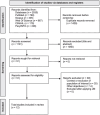Planning, implementation, evaluation, and sustainment of digital health interventions for adolescent substance use prevention: a systematic review of influencing factors based on the RE-AIM framework
- PMID: 40397545
- PMCID: PMC12094073
- DOI: 10.1093/her/cyaf021
Planning, implementation, evaluation, and sustainment of digital health interventions for adolescent substance use prevention: a systematic review of influencing factors based on the RE-AIM framework
Abstract
School-based health interventions can help prevent adolescent substance use, but their success depends on various factors affecting planning and evaluation. This study examines the factors that facilitate or hinder the success of school-based digital health interventions. A systematic review was conducted in September-October 2024, following PRISMA guidelines, using PubMed, Scopus, Web of Science, CINAHL, and PsycINFO databases. From a total of 2530 studies, after removing duplicates and screening titles and abstracts, 51 full-text articles were assessed and 12 met the inclusion criteria. Data were extracted using an adapted tool for systematic reviews applying the RE-AIM (Reach, Effectiveness, Adoption, Implementation, and Maintenance) framework. The methodological quality was assessed with Joanna Briggs Institute tools. The studies included cluster-randomized controlled trials, quasi-experimental designs, and one cross-sectional study, primarily targeting adolescents aged 11.9-17.4 years, with sample sizes ranging from 90 to nearly 5000 participants. Most interventions were implemented in schools in the USA, Europe, and Taiwan, with balanced gender distribution. Many studies reported on reach and effectiveness in reducing substance use, particularly alcohol. However, adoption and implementation factors influencing school participation were less frequently addressed, and maintenance was not mentioned. To maximize impact, future efforts should focus on enhancing sustainment and participation by leveraging emerging technologies for personalization.
© The Author(s) 2025. Published by Oxford University Press.
Conflict of interest statement
None declared.
Similar articles
-
The effectiveness of interventions to meet family needs of critically ill patients in an adult intensive care unit: a systematic review update.JBI Database System Rev Implement Rep. 2016 Mar;14(3):181-234. doi: 10.11124/JBISRIR-2016-2477. JBI Database System Rev Implement Rep. 2016. PMID: 27532144
-
Education support services for improving school engagement and academic performance of children and adolescents with a chronic health condition.Cochrane Database Syst Rev. 2023 Feb 8;2(2):CD011538. doi: 10.1002/14651858.CD011538.pub2. Cochrane Database Syst Rev. 2023. PMID: 36752365 Free PMC article.
-
Health professionals' experience of teamwork education in acute hospital settings: a systematic review of qualitative literature.JBI Database System Rev Implement Rep. 2016 Apr;14(4):96-137. doi: 10.11124/JBISRIR-2016-1843. JBI Database System Rev Implement Rep. 2016. PMID: 27532314
-
School-based education programmes for the prevention of unintentional injuries in children and young people.Cochrane Database Syst Rev. 2016 Dec 27;12(12):CD010246. doi: 10.1002/14651858.CD010246.pub2. Cochrane Database Syst Rev. 2016. PMID: 28026877 Free PMC article.
-
Strategies for enhancing the implementation of school-based policies or practices targeting risk factors for chronic disease.Cochrane Database Syst Rev. 2017 Nov 29;11(11):CD011677. doi: 10.1002/14651858.CD011677.pub2. Cochrane Database Syst Rev. 2017. Update in: Cochrane Database Syst Rev. 2022 Aug 29;8:CD011677. doi: 10.1002/14651858.CD011677.pub3. PMID: 29185627 Free PMC article. Updated.
References
-
- World Health Organization . WHO Guideline: Global Strategy on Digital Health 2020-2025. Geneva: WHO, 2021
-
- World Health Organization . WHO Guideline: Recommendations on Digital Health Interventions for Health System Strengthening. Geneva: WHO, 2019 - PubMed
-
- World Health Organization . Classification of Digital Health Interventions v1.0. Geneva: World Health Organization. 2018. 1–20. (WHO/RHR/18.06). https://www.who.int/publications/i/item/WHO-RHR-18.06 (19 April 2025, date last accessed).
-
- World Health Organization . WHO Guideline: Youth-centred Digital Health Interventions: A Framework for Planning, Developing and Implementing Solutions with and for Young People. Geneva: WHO, 2020
Publication types
MeSH terms
Grants and funding
LinkOut - more resources
Full Text Sources
Medical
Miscellaneous


